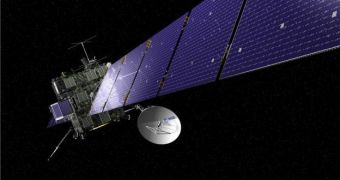Last Thursday, the European Space Agency's (ESA) Rosetta space probe managed to perform one of the most successful trajectory correction maneuvers (TCM), according to officials at the agency. The spacecraft's gravity-assist maneuver was very close to projections, and it is now well on its way to meeting up and studying the comet 67P/Churyumov-Gerasimenko, in 2014. The spacecraft also contains the Philae lander, whose main purpose is to land on the space rock, and provide in situ measurements of its characteristics, AlphaGalileo reports.
“The maneuver was very close to the predicted and required amount. We will continue to analyze the results to determine whether we will need any additional maneuvers,” ESA Flight Dynamics lead specialist Trevor Morley says. A number of scientific sources was used to infer the new conclusion, the expert adds, including the telemetry radioed down by Rosetta, and Doppler / ranging data received from ESA and NASA ground stations.
The Rosetta telemetry also included star-tracker data and parameters related to fuel usage and thruster operations, which were extremely useful in determining the chances the spacecraft had of meeting its target. There were some highly complex mathematics involved in planning the meeting between the space probe and the comet, and all of those calculations need constant revising in order to ensure their accuracy. Preliminary analyses show that the 86-second thruster burn slightly over-performed, in the range of 0.06-0.07 percent, but that the new predicted time of the closest approach (or perigee passage) will take place on November 13, at 08:45:40 CET.
ESA's 35-meter DSA 1 station in New Norcia, Australia, and NASA's DSN antennas, in Goldstone, California, and Robledo, near Madrid, were involved with providing the space agency with the tracking information it needed to survey Rosetta.
The lander robot, Philae, is the first exploration device that will fire harpoons at the surface of the comet, so as to avoid bouncing off it. It will approach the rock at a speed of about one meter per second. After it fires two harpoons into 67P, additional drills will lock it tightly in place. Philae's mission has three main objectives, the study of the comet's nucleus, determining its chemical composition and studying its activities and development over time. The thing about the lander is that no surface map of the comet exists, so the craft will have to make one, before landing.
ESA experts are hopeful that a place to land will be found, once the maps are analyzed. There are ten scientific instruments on Rosetta and its lander, including spectroscopes, spectrometers, ion-mass analyzers, and dust-analysis systems. The orbiter was named after the famous Rosetta Stone that helped experts understand Egyptian hieroglyphic writing, while the lander is named after the Nile island Philae, whose obelisk helped decipher the tablet.

 14 DAY TRIAL //
14 DAY TRIAL //